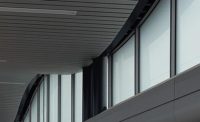Over the years, building and design professionals have employed a variety of wall assembly design techniques to meet the acoustic control requirements of projects. Some of these traditional methods have earned a reputation for being expensive or too problematic, as even minor installation errors can compromise the acoustical performance of the entire wall assembly. With the advent of new technology and innovation, however, building product manufacturers are developing newer, more practical solutions for acoustic control. In addition, they are working to educate customers on the fundamentals of acoustic science to help guide them toward the best material choices for an acoustical wall assembly.
ACOUSTIC SCIENCE FUNDAMENTALS FOR WALLS
To solve acoustical problems, building and design professionals must first consider three elements: the sound source, the path that sound travels and the sound receiver at the end of the path. Sound originates from various sources outside the building or adjacent spaces inside the building. Sound transmission paths are building elements, such as wall assemblies, through which noise from the sound source travels. And, the receiver is a person or group of people who occupy the space.
All background noise found in an interior environment is generally referred to as ambient noise. Though it’s certainly common for interior environments to have at least minimal levels of ambient noise, excessive noise can seriously hinder building occupant communication and concentration. In spaces with excessive ambient noise, it is generally accepted that most people would need to speak at least 15 decibels (dB) louder than the ambient noise level in order to be heard at all. So, what might otherwise result in a moderate sound level for conversation (40 – 60 dB), can encroach into the loud sound range (60 to 80 dB). Therefore, it is generally preferred for ambient noise to be less than 40 dB in a space where conversation or speaking is taking place.
After acceptable ambient noise levels are established, the project focus turns to finding the best ways for restricting unwanted sound from entering the spaces of the design. A very important part of this process is the specification of wall assembly components that block the transmission of ambient noise through them. The measurement used to gauge the ability of wall assemblies to contain this noise is the sound transmission class rating. A higher STC rating means that more airborne noise is blocked by the component or assembly. Conversely, components or assemblies with lower STC ratings permit more sound to pass through them, raising the ambient noise level of the space.
Sound generated on one side of a wall will energize the wall structure and set it in motion, much like a diaphragm. The wall then transmits the sound energy, which can be heard on the opposite side of the wall. The ASTM test methods used to determine STC use this direct transmission process and derive the STC number from sound attenuation values tested at 16 standard frequencies from 125 Hz to 4000 Hz. These transmission-loss values are then plotted on a sound pressure level graph, and the resulting curve is compared to a standard reference contour. Acoustical engineers fit these values to the appropriate Transmission Loss (TL) curve to determine a final STC rating.
Acoustic control has increasingly gained recognition in recent years as a key component of sustainable design, due to its role in creating positive indoor environmental quality. Its growing importance is evidenced by its inclusion in the requirements of prominent green building programs and codes, such as LEED for Schools, the Green Guide for Health Care and the International Green Construction Code (IgCC). Let’s look at the two construction market drivers that stand to benefit most from acoustical wall assemblies—schools and healthcare facilities.
ACOUSTIC CONTROL IN SCHOOLS AND HEALTHCARE
In schools, it’s imperative to create an effective learning environment, which requires clear communication between teachers and students. Ambient noise in schools, such as conversations in hallways, sound systems, students in neighboring classrooms and mechanical equipment, can easily distract students and interfere with teacher-student communication. Ambient noise also leads teachers to raise their voices, which often results in vocal strain over time. Concerns like these have led to more stringent school acoustical requirements for both new construction and remodels from leading building standards, such as ANSI Standard S12.60-2002: Acoustical Performance Criteria, Design Requirements and Guidelines for Schools and LEED for Schools.
It is crucial for all healthcare facilities to provide a very comforting, low-noise interior environment that is conducive to healing. In hospitals designed and constructed with close attention to acoustic control, patient satisfaction is higher and their sleep quality is improved. The construction and remodeling of healthcare facilities is guided by a variety of contemporary building standards, all designed to make sure patients receive the best environment for healing. Again, acoustical requirements play an important role, especially in the Health Insurance Portability and Accountability Act (HIPAA), IgCC Acoustics Section 807, LEED for Healthcare and Sound and Vibration Design Guidelines for Health Care Facilities, an ANSI standard currently in the developmental stages.
Now, let’s look at a growing trend in gypsum board products that provide building and design professionals an easier route to desired STC ratings for wall assemblies—laminated noise-reducing gypsum board.
LAMINATED NOISE-REDUCING GYPSUM BOARD
Designing wall assemblies with a variety of strategically placed layers and materials has been a common method for achieving desired STC ratings over the years—one that, unfortunately, hasn’t come without its share of drawbacks. For instance, strategies like adding multiple layers of gypsum board, installing noise-dampening resilient furring channels or isolation clips and building double-stud walls, can be quite effective but are often costly and time consuming. Incorrect placement of the boards or improper installation of the resilient furring channels and isolation clips can compromise the sound containment abilities of the wall assembly. One contemporary solution to these problems is laminated noise-reducing gypsum boards.
Laminated noise-reducing gypsum boards are a high-performance, more easily installed alternative to most traditional acoustic control methods used on interior walls in residential, commercial or institutional applications. A factory-made version of a sandwich-style field fabrication sometimes used by drywall contractors, the boards consist of a layer of viscoelastic polymer applied between two specially formulated thin layers of gypsum board. The final product ends up being 1/2 to 5/8 inch thick, or the same as traditional gypsum board. The boards have the ability to impede sound transmission by using the inner polymer layer as somewhat of a shock absorber. The polymer converts the acoustic energy into thermal energy that is dissipated across polymer sound transmission. This type of “constrained layer damping” board product performs well acoustically over an extended range of frequencies and significantly increases STC ratings for the assembly.
Wall assemblies that use a single layer of noise-reducing gypsum board have been tested and shown to meet or exceed the acoustic performance of assemblies that use double layers of traditional gypsum board. In fact, these boards have been shown to increase the wall assembly’s STC rating by 10 or more points, while adding an extra layer of traditional gypsum board increased STC by two to three points. Laminated acoustical gypsum board is therefore an excellent acoustic solution for meeting STC requirements, such as isolation clips or resilient channels. Directly applied to framing, they provide more consistent and predictable acoustic performance. The laminated boards can still, however, be used in conjunction with resilient channels or clips in wall assemblies to achieve extra sound transmission control. In these cases, the material would also help reduce the negative effect of any short circuits.
Using single-layer noise reducing gypsum board can also help reduce material usage, versus traditional multi-layered gypsum wall. The high acoustic performance of the product makes it possible to build effective noise-reducing walls with less material, conserving valuable square footage, and saving both construction time and material cost. Less material used also means a more sustainable structure.
EDUCATE THE CUSTOMER
Some gypsum board manufacturers are now taking a broader approach to bring noise-reducing gypsum and other high-STC wall assembly options to a wider variety of construction markets, as the need for sound attenuation is ubiquitous. With their superior sound attenuation properties, noise-reducing gypsum boards are certainly gaining popularity among architects and designers working on acoustically sensitive commercial construction projects. And, it’s not unreasonable to foresee these products moving into the residential market, as well, as a media room acoustic control option in single-family homes.
CertainTeed Gypsum, for instance, recently launched dBstation, an industry-first interactive tool, which simulates the acoustical performance of a variety of wall assemblies. Designed for use on the Apple iPad or Motorola Android mobile devices, dBstation allows architects, builders, and homeowners to actually hear the acoustical differences of wall systems in real-world applications and share these results with their clients. Tools like this and more concise information from manufacturers can only help them guide clients toward the best product and design decisions for their specific acoustical needs.
AN EXCELLENT FIT
In addition to superior acoustic control properties, most of today’s noise-reducing gypsum boards have moisture- and mold-resistant face and back papers and offer an economical single-layer alternative to multi-layer gypsum board configurations in wall and ceiling assemblies. The result of this combination is improved sound attenuation for high-STC assemblies in various building settings, distinct contributions to green building design, and an important role in meeting the emerging acoustical standards needed to ensure optimal IEQ. Noise-reducing gypsum boards are a wise all-around choice for a wide breadth of projects.
















